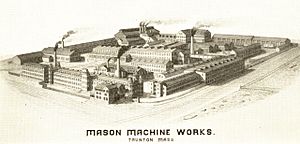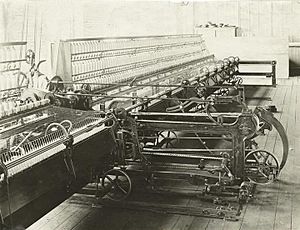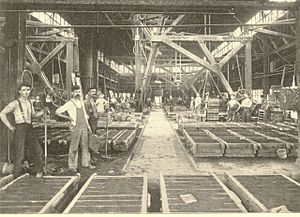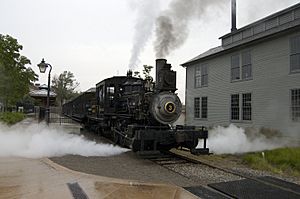Mason Machine Works facts for kids
The Mason Machine Works was a company that built machines in Taunton, Massachusetts. It operated from 1845 to 1944. The company became well-known because its founder, William Mason, invented something special. This invention was called the "self-acting mule," and he got a patent for it in 1840. This machine helped make cloth.
Later, the company also made other things. They built steam locomotives (train engines) and even rifles during the American Civil War. They also made printing presses. But making machines for the textile industry (which makes fabric and clothes) was their main business for a long time. This continued until the 1920s, when the company started to slow down.
Contents
Meet William Mason: A Master Inventor
William Mason was born in 1808 in Mystic, Connecticut. His father was a blacksmith. William became a very skilled mechanic when he was still a teenager. He worked for different companies in the Killingly, Connecticut, area. These companies made machines for the growing textile industry.
In 1835, Mason moved to Taunton, Massachusetts. He started working for a company called Crocker and Richmond. This company made machines called ring spinning frames for cotton factories. The company faced problems during a money crisis in 1837. But another company, Leach and Keith, soon took over. Mason was made the foreman, which is like a team leader.
Amazing Textile Machines
When William Mason started his career, the United States had a growing industry for building machines. This was a special skill. It needed specific tools, materials, and designs. These ideas had been getting better and better since the early 1800s. Early machine builders like David Wilkinson in Pawtucket, Rhode Island, and Paul Moody in Waltham, Massachusetts, kept improving their inventions.
On October 8, 1840, Mason got a patent for his most important invention. It was called the "self-acting mule." This machine was a big step forward in automation. It could do many tasks by itself. He improved it and got another patent on October 3, 1846. This "self-acting mule" became the best machine of its kind for many years.
After Leach and Keith closed in 1842, William Mason found people to invest in his own company. This new company was the Mason Machine Works. In 1845, new buildings were built. The factory became the largest in the country dedicated to making machinery. They made machines for cotton and wool factories. They also made tools for mechanics, blowers, and parts for furnaces. They even made railroad car wheels with spokes.
The Mason Machine Works became the most important company in Taunton, Massachusetts, for much of the 1800s.
Building Powerful Locomotives
After 1852, the company grew even more. They started making locomotives, which are the engines that pull trains. Mason's new train designs were very popular. Railroad engineers and operators praised them. His engines were also known for being easy to fix. Other locomotive builders later used many of his ideas and improvements.
The company built 754 steam locomotives between 1853 and 1889. However, after William Mason passed away in 1883, the company mostly focused on its main business: textile machinery.
Two locomotives built by Mason are still around today. One of them can even run!
- One is the Baltimore and Ohio Railroad's number 25. This train was built in 1856 and was later named after William Mason. It is a 4-4-0 type engine. You can see it at the B&O Railroad Museum.
- The other working locomotive is Hecla & Torch Lake Railroad Number 3. This is a 0-6-4 engine with a special Mason Bogie design. It was built in 1873. You can find it at the Henry Ford Museum.
Also saved is a part called the tender. This tender originally belonged to a train called the Dalton. Mason Machine Works built the Dalton in 1864 for the United States Military Railroad during the Civil War. After the war, the engine was sold. It became the Western and Atlantic Railroad's William MacRae. When that engine was retired in 1890, its tender was saved. It was then used with the famous Texas locomotive, which was built by Danforth, Cooke and Company.
Rifles and Printing Presses
In 1861, the Civil War began. Mason Machine Works got a contract from the United States Government. They were asked to make 100,000 Springfield model rifles. The company expanded its factory a lot to handle this big order. However, the War Department later decided to cut the order to only 30,000 rifles.
After the war, the company went back to making high-quality textile machines and locomotives. The factory grew to cover more than 10 acres (40,000 m2) near downtown Taunton.
In 1879, Mason's good reputation for quality work led to another contract. They started making the Campbell printing press. This press was first invented and built in Brooklyn, New York.
The End of an Era
In the 1920s, the textile industry in the northern United States began to decline. Because of this, Mason Machine Works mostly made spare parts for the machines they had sold before. They sold to fewer and fewer textile factories. By the 1930s, other companies started using parts of the old Mason factory site.
The Mason Machine Works finally closed down in 1944.
Today, a bus depot and garage, an apartment building, and other businesses are on the site. Some parts of the land are still empty. This is likely because of soil contamination from the old factory's operations.
Images for kids











